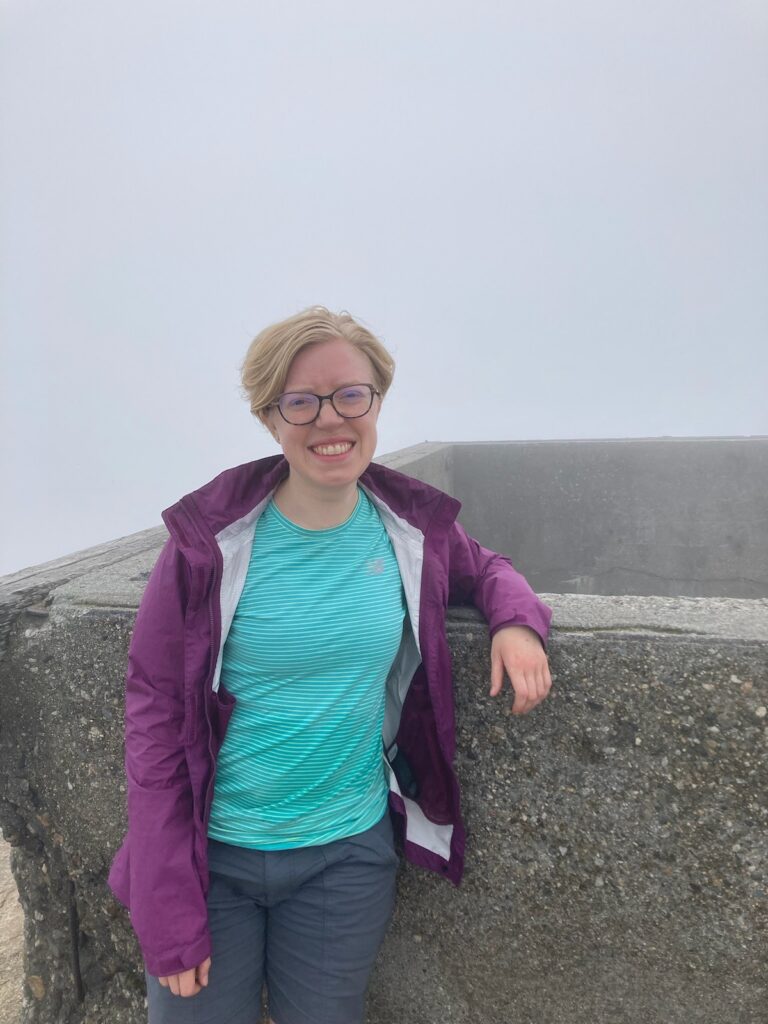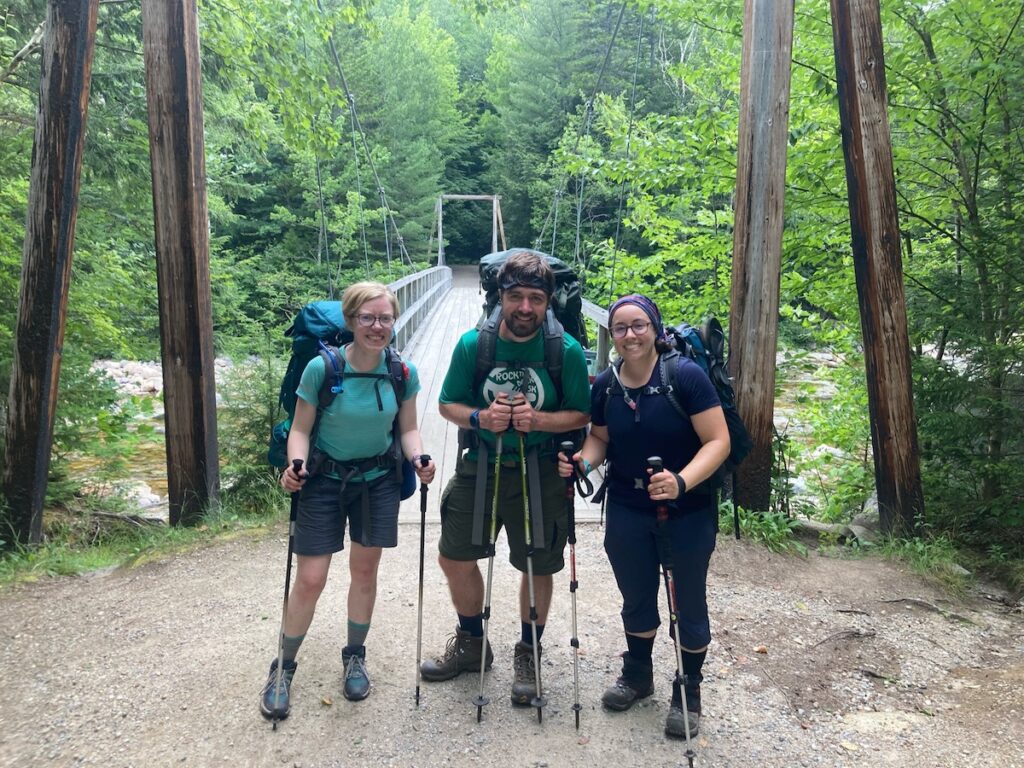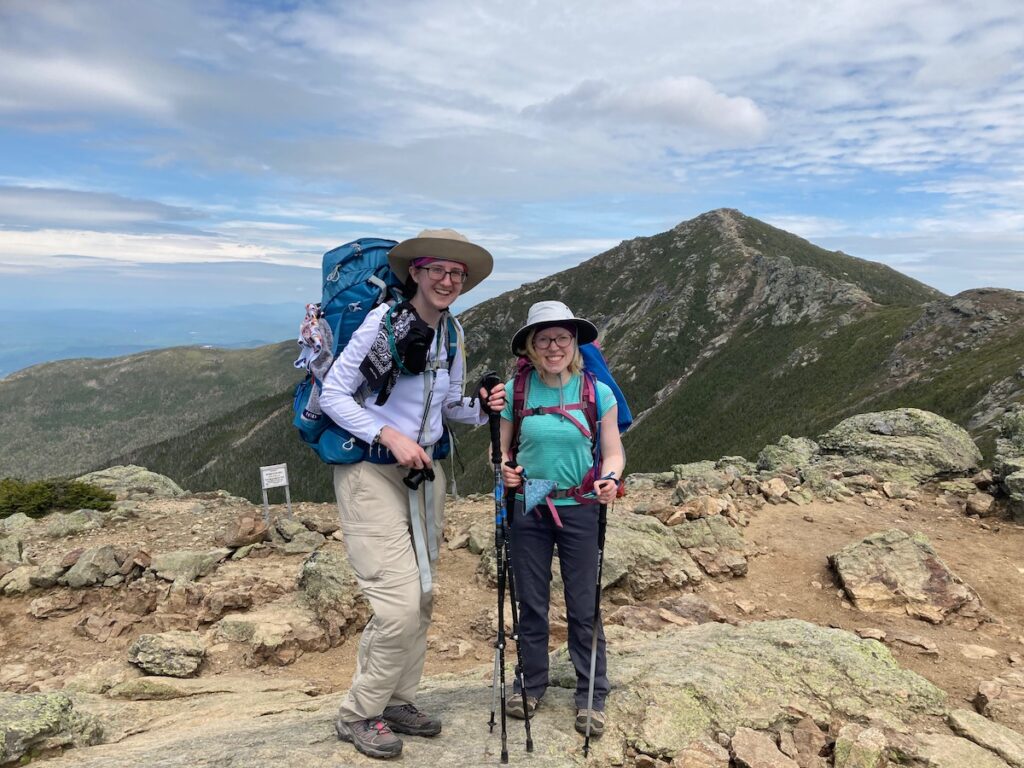“I need to get the hell off this mountain now,” was all I could think. Footsore and at the end of our ropes, my friend Katie and I had just stumbled into the Garfield Ridge campsite after a roughly 8-mile hike that had taken us all day and nearly broken us. I felt humbled and slightly embarrassed to have assumed I could complete a Pemi Loop, in less-than-great shape and on my second-ever backpacking trip. What had I been thinking?
Katie and I met during our sophomore year of college and soon discovered shared interests ranging from Star Wars to epistemology. Above all, I was drawn to Katie’s infectious goofiness and unbridled enthusiasm for nearly everything. Our friendship endured throughout the ensuing years despite our paths diverging in a keyway as we each grappled with the mental health challenges that accompanied our forays into adulthood: Katie gravitated toward and eventually embraced traditionalist Catholicism even as I was shedding first the practices and then the beliefs that underpinned my Catholic upbringing. Still, we never shied away from deep and intense philosophical discussions, even as they became more challenging.
Our first backpacking trip together had been four years earlier in Vermont. We were joined by two other companions, friends of Katie’s from her hometown, and the trip had been a fun, relaxed affair. We met only minor obstacles (like trying to hang an oversized bear bag containing all four people’s food in the dark) and bonded over our shared love of the outdoors, not to mention the gradual breakdown of bodily-function taboos that seems to be an inevitable part of a hiking trip. Upon completing the trip, we expressed a mutual intention to reunite for a future trek, but conflicting schedules, various distractions, and then the pandemic got in the way until early 2021, when we finally began laying plans to take on a new and bigger challenge together.
It was Katie’s idea to tackle the Pemi Loop. While preparing for an AT thru-hike attempt in 2016, she’d set up a blog and selected a picture of the iconic Franconia Ridge as the banner photo. After her hike was cut short by a knee injury, she’d continued to dream of that ridgeline and longed to see it for herself someday.
Despite Katie’s warnings and serious approach to preparation, which included a PowerPoint presentation and an exercise routine, my training was admittedly pretty lackluster. That spring, I’d been preoccupied with purchasing a home and had closed just a few days before our hike, the same day I got my second dose of COVID vaccine, which laid me low with a fever and body aches for 24 hours. I would later learn that I also had a mild case of iron-deficiency anemia. No doubt all of these factors contributed to the severe fatigue and soreness I experienced on the trail, as did a poorly fitted pack and the 10-year-old boots that I should have replaced beforehand.
Taking into consideration our relative lack of experience, we had planned to complete the hike in four days rather than the three that seemed to be the more common option, limiting ourselves to a conservative daily mileage between six and eleven. It was ambitious, I thought, but doable—we could take it slow and take plenty of breaks. The first day went pretty much to plan: we made it into our first campsite at Liberty Springs in good spirits and with plenty of time despite having gotten a slightly late start to the day and lingered to take in the views atop Mount Flume and Mount Liberty.
Day two, however, proved to be rather more stressful: first, we faced the punishingly steep climbs to the summits of Lincoln, Little Haystack, and Lafayette, which took over half of the day, our packs weighing ever more heavily on us and the complaints of our unacclimated muscles and joints growing ever more insistent. Worse, we then faced a seemingly unending stretch during which Mount Garfield loomed in the still-faraway distance, yet another imposing obstacle between us and camp. Increasingly, we found ourselves glancing nervously at our watches, silently subtracting the hours remaining until sunset and wondering if our snail’s pace would get us off the trails before we’d have to pull out our headlamps and brave the slippery, rocky steps in the dark.
At one point we came to a rock face perhaps seven or eight feet high, vertical and smooth enough to send us each into a barely suppressed panic. To a more experienced climber, it would perhaps have registered as little more than an inconvenience, but to us it felt genuinely dangerous. Making matters worse, I initially chose a suboptimal route to the top, found myself unable to complete the climb, and had to drop my pack to the ground before jumping back down myself. “Well, the only way out is through,” I thought, collecting myself. I took a few deep breaths and tried another route, finding success this time, and Katie followed shortly thereafter. Discussing it later, we found that we’d each been silently confronting the very real possibility of grievous bodily harm, the vivid image of a hand or foot failing to find purchase in the rock and a 25-lb. pack pulling one over backwards, accelerating the tumble onto the unforgiving ground below.

Prior to our hike, I’d had only a vague sense of how the Pemigewasset Wilderness compared to the area we’d hiked in Vermont. I knew based on the statistics to expect steeper inclines and more elevation gain, and I’d read the descriptions of the Pemi Loop as challenging, even unforgiving, but having done little hiking in the White Mountains, I lacked the experience to anticipate the rockiness, the knee-destroying steps, and the amount of scrambling required—a skill which I’d had little occasion to practice.
Moreover, I had not been able to visualize how remote these trails felt. There were no logging roads or easy shortcuts to the summits and campsites we visited, and the farther we got from the trailhead, the more I found myself ruminating on the challenges and delays that would be entailed in getting help if we needed it. And increasingly I found myself envisioning catastrophe, my anxiety taking over each time my foot slipped on a wet rock, or the weight of my pack shifted abruptly during a scramble, or even when I felt my heart rate rising uncomfortably high during a climb in the unseasonably warm weather. Unlike on our Vermont trip, I was far from actually enjoying myself, which had been the whole point.
I was relieved when Katie seemed to share my sentiment and even more so when, the next morning, a kind woman who had blazed past us on the Franconia Ridge the previous day saw us breakfasting at the Garfield Ridge campsite, overheard our conversation, and stopped to share advice. She recommended that we take the Franconia Brook Trail back to the Lincoln Woods trailhead, assuring us that, while somewhat long, it was an easy walk through the valley. The one tricky section of this bailout route, she warned us, was right at the beginning, when we’d have to descend a steep and rocky section with a snowmelt-fed stream running through it, making it virtually a small waterfall.
Neither of us fully registered what this meant until we came upon the section in question. For a moment we scratched our heads, thinking that we’d gone astray, as the trail seemed to end abruptly at what looked like the site of a former rockslide. Spotting a clearly marked white blaze on a tree, we came to the queasy realization that this was in fact our trail: rocks piled steeply and precariously in a long slide, many of them made treacherously slick by the vigorous stream rushing through them. “The only way out is through,” I told myself again, and began my painstaking descent, followed by Katie, who picked her way down with the same unspoken yet palpable anxiety.
Fortunately, after that point, the hike was as easy as promised, and we marveled at the relative speed with which we ticked off the miles until we got back to the trailhead. We’d be back someday for redemption, we told each other, at some hazily defined point in the future when we were better trained and, perhaps more importantly, had forgotten how much our semi-Pemi had beaten us up physically and mentally.
At the end of our journey, besides the muscle aches and residual stress, a familiar wedge continued to trouble each of us. There had been small moments of tension, like when Katie expressed her enjoyment of Chick-fil-A or when, on the drive up, I remarked that the driver of the car in front of us, with its slew of liberal bumper stickers, including a Planned Parenthood one, seemed like “my kind of person.” Over the course of the long days on the trail, the resentments that had grown within me throughout the pandemic leaked out, and I found myself sometimes filling the silences by ranting about my frustrations with anti-vaxxers, etc. Katie, who struggled to express negative emotions, grew increasingly silent on the drive back to my place in Massachusetts and only worked up the resolve to talk to me about it some time later. I learned then that she had been disturbed by my animus, especially as she sometimes aligned herself with its targets.
I was grateful for the opportunity to clear the air, knowing that a hot temper and a tendency to get ranty are among my vices, but wanting to make it clear that I did not bear genuine ill-will toward Katie—or any others for that matter, even if I deemed their beliefs and actions harmful. I suggested that we find a shorthand to express our discomfort, to shake us out of tendencies toward tribalism that might emerge in stressful situations, to remind us that we were a team. “What about ‘Garfield’?” I suggested. She grinned. Immediately the name evoked racing the sunset, conquering the dread of an arduous trek and a looming peak, perhaps even cheating death with a treacherous scramble up a steep rock where one slip or misstep could spell disaster. It conjured up a vivid memory of a shared challenge and a goal we had achieved together despite our differences.
…
As it happened, danger was not just lurking out in the wilderness; it came for Katie much closer to home. Two months after our hike, I talked to a friend of her family on the phone. There had been an accident, on a road just a couple miles from Katie’s house. Katie hadn’t made it.
Grief struck me with an intensity I had never experienced. I’d lost loved ones before, but not peers, and not with this suddenness. The word “senseless” rattled around incessantly in my brain. I had thought I understood what people meant when they used it, and I only now realized that I hadn’t been able to fathom what senselessness actually felt like: a young woman plucked abruptly from this world a month after her 31st birthday, all her dreams and plans for the years ahead rendered null in an instant. She was supposed to keep exploring her newfound passion for photography. She was supposed to return to her a career as an elementary school teacher and influence the lives of hundreds of children with her compassion and unflagging optimism. We were supposed to have so much time to return to the mountains together.
…
After Katie’s death, my resolve to complete the Pemi Loop solidified. No longer a vague dream, it became a mission I needed to achieve, a meaningful act to push back against the meaninglessness of loss. So, two days before the one-year anniversary of her death, I embarked once again, this time in the reverse direction, with two friends who had not known Katie but who had (and continue to be) incredibly supportive of me in the grieving process. Tucked in the hip belt of my pack was a laminated prayer card from Katie’s funeral featuring a portrait of her smiling the candid smile that came so naturally to her.

I desperately wanted to complete the hike this time, but knowing how this trail had wrecked me before, I feared I would once again reach my breaking point. I was better prepared this time around, to be sure, but my preparation was still far from ideal, and the possibility of having to bail out again lurked in the back of my mind. The first afternoon of our trip, it poured rain, leaving our socks squelching in the puddles that filled our shoes and slickened the rocky trails. We arrived at the Guyot Campsite shivering and miserable, glad of the opportunity to squeeze into the trail shelter amid a dozen snoring strangers just to avoid pitching our tents in a downpour. But on day two, the conditions slowly improved, and the socked-in conditions at the summit of South Twin gave way to sunshine on the meadow by the Galehead Hut, where we stopped to eat our lunch. From that point on, the sun prevailed, and our cheeriness became less forced as we dried out and got to enjoy the mountain vistas that emerged from the fog.
Our greatest obstacle on day two came just before the Garfield Ridge campsite: the “waterfall.” I’d forgotten that it was part of the main Pemi route and not the previous year’s bailout route. I cursed. I wasn’t sure what was worse, descending or climbing, but either way it terrified me. I’d slipped on a wet rock not long before and could feel my legs growing weaker as I tired. I asked to lead so that I could push through at my own pace, moving carefully but swiftly up the rocks, feeling that if I paused, I risked a panic attack. “Be with me, Katie,” I said as I gripped a sodden boulder and hoisted myself upward. I put the rockslide behind me with a speed that surprised me. In camp that evening, I felt tired but strong, and my resolve held firm. I could go on.
One year to the day after Katie’s death, I once again summited Garfield, then made my way across the Franconia Ridge. The previous year’s dread was replaced by a growing sense of triumph, especially as I climbed Lafayette, the tallest peak on our hike. “Can you believe it, Katie? I miss you so much,” I said to her, wiping away my tears before my friends caught up to me. Before our hike, I’d had a vague longing to perform some kind of ritual that day, but neither the Catholic rites of my childhood nor any New-Agey substitutes felt quite right. As I climbed and sweated, muscles aching and heart pounding, I felt more and more that hiking was the ritual I was seeking. To be present in the moment, to be so aware of what it means to be alive and embodied, to be humbled by the magnificence of the world around me, and above all to be in communion with others, sharing with and supporting one another: what better way to honor Katie’s memory?
Despite some blisters and some creaky joints, we were in good spirits at Liberty Springs that night, our doubts, and misgivings about completing the hike having faded. From there, it was just a short push up Liberty and then Flume, followed by a long and increasingly gentle descent until we crossed the bridge over the Pemigewasset River. There, a friendly couple captured our excited grins on camera as we stood near the trailhead. We’d done the thing that had felt impossible just one year earlier.
The lessons of that trip are still unfolding, as are the lessons of my friendship with Katie, and I still often struggle to unpack them. How do I find common ground with someone whose values are structured on a system that is fundamentally at odds with my own moral foundation? When should I remain silent to keep the peace, and when should I challenge statements or assumptions that I disagree with? How can I speak and live my truth without being combative or alienating others? How can I be more patient, more compassionate even when I’m angry or stressed or frustrated? I still don’t know. But I can picture Katie’s smile and hear her gently reminding me: “Garfield!” She says it with her characteristic laugh, at once mischievous and kind, and it reminds me that I need to step back, to de-center myself from my narrative for a moment. I am not alone. And together we can do hard things.














